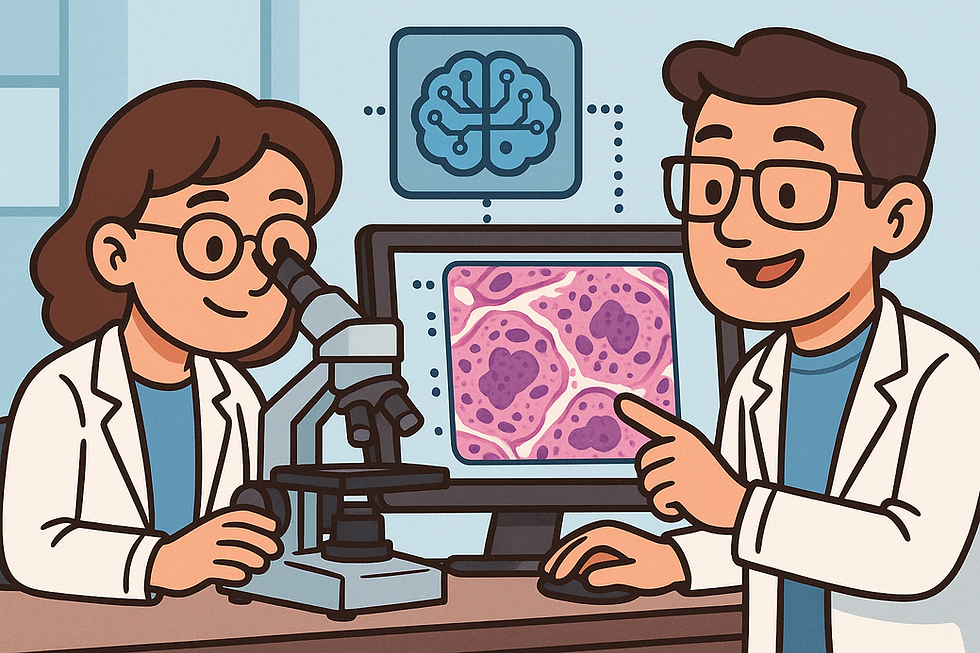How PathAI is Using AI to Eliminate Diagnostic Guesswork
- Zofia Krajewska
- Aug 7
- 4 min read
Updated: Aug 21
The story of one company’s bet on clinical-grade AI in a field long considered impossible to digitise.
During his pathology rotation in med school, Dr. Andy Beck found himself squinting at stained tissue through a microscope, frustrated by the subjectivity and complexity of what he saw. Years later, as a Harvard pathologist and professor, he was still running into the same bottlenecks with too many slides, not enough precision, and wide variation in how different doctors interpreted the same data.
In 2016, Beck co-founded PathAI, a Boston-based company which is now one of the most closely watched players in the medical AI space, and the following is the story of one company's bet early on clinical-grade AI, in a field that until now was until now undigitisable.

Outside of academic circles, there is a misconception that pathologists always agree on diagnosis. But, in reality, the same slide can result in extremely varied conclusions depending on the day, the person, or even how much sleep they had. This creates a real patient safety issue, touching everything from breast cancer staging to liver biopsies for clinical trials.
Beck's co-founder, Aditya Khosla, is an MIT-trained computer scientist and entrepreneur who had worked on machine vision at the MIT Media Lab and cofounded two startups before age 30. Within their duo, Khosla brought the deep learning chops, while Beck brought the medical credibility.
They quickly realised that together, they could train AI to diagnose disease from pathology slides with consistent, reproducible accuracy. They argued that if computers could be trained to recognize tumors the way they recognize cats or stop signs, then pathology could be reimagined not as a subjective discipline, but as a data science.
Challenges in building clinical-grade AI
One of PathAI's first challenges was acquiring a high volume of data to train their AI on. Digitising glass slides requires high-resolution scanning, and annotation is painstaking, requiring hours of expert pathologist input.
PathAI stared with building an in-house annotation infrastructure, contracting dozens of board-certified pathologists to label millions of image patches. Instead of relying on small, public datasets, they trained on some of the largest proprietary datasets in the industry. This allowed their deep learning models (consisting mostly of convolutional neural networks) to handle the complex texture, scale, and heterogeneity of tissue slides, from tumor-infiltrating lymphocytes to rare histologic subtypes.
Next, PathAI pursued rigorous validation, aligning with pharmaceutical partners to test their models in real-world scenarios, including identifying responders in immunotherapy trials, standardizing biomarker readouts, reducing inter-observer variability.
Eventually, in a study on non-alcoholic steatohepatitis (NASH), PathAI’s model matched or exceeded expert accuracy in staging liver fibrosis, a notoriously subjective process with high clinical stakes. That model is now in active use in clinical trials.
The Business Model
PathAI’s needed to position itself as a tool to solve pharma's pain points, namely those of heavily relying on pathology to stratify patients and assess response, and those of high variability contributing to sub-optimal trial outcomes. PathAI provided the algorithmic consistency that pharma needed to improve its trial design and biomarket validation.
Soon, PathAI signed partnerships with Bristol Myers Squibb, Roche, and Gilead, with the company's AI used to support drug development in oncology, NASH, and infectious disease. With each collaboration, PathAI grew in credibility, and the kind of regulatory exposure needed to bring AI into the clinic.
That exposure culminated in 2023 when PathAI received FDA Breakthrough Device Designation for its NASH AI-based measurement tool, clearing a critical regulatory hurdle. The company is now actively pursuing FDA clearance for multiple products, including diagnostic support tools and predictive biomarkers.
Winning Over Pathologists
Early on, there was a lot of fear that AI would replace pathologists rather than being their ally. PathAi always framed its tool as augmentation, giving pathologists more precision, rather than removing them from the equation.
The company has invested heavily in building user interfaces that pathologists trust, with clear provenance for every model prediction. They were careful about avoiding the creation of a black box, but rather a tool to help pathologists see what they might have missed or confirm what they suspected. PathAI's team has heavily debated explainability, error thresholds, and model drift. Every decision, whether to flag a borderline tumor region or when to trigger a second read, is filtered through clinical pragmatism.
The Future: Full-Stack Pathology and Beyond
Today, PathAI employs over 300 people and has raised more than $250 million in funding, including backing from General Catalyst, Kaiser Permanente, and Labcorp.
In the long-term, the team is looking beyond AI-assisted diagnosis, into a fully integrative pathology ecosystem. In 2021, the company acquired Poplar Healthcare, a national pathology lab, giving it a physical footprint for end-to-end testing and allowing for integrating AI directly into diagnostic workflows and build real-world evidence at scale.
With enough annotated histopathology and outcomes data, PathAI could also branch into drug discovery to potentially identify novel biomarkers or even therapeutic target. For now, though, the company is focused on clinical translation. They’re working closely with the FDA, refining post-market surveillance strategies, and expanding use cases in oncology, liver disease, and dermatopathology.
If PathAI succeeds, the implications go far beyond efficiency. It would mean pathology, long-seen seen as a subjective art, becomes a reproducible science, with fewer missed diseases, fewer failed therapies, and fewer diagnostic errors.




Comments